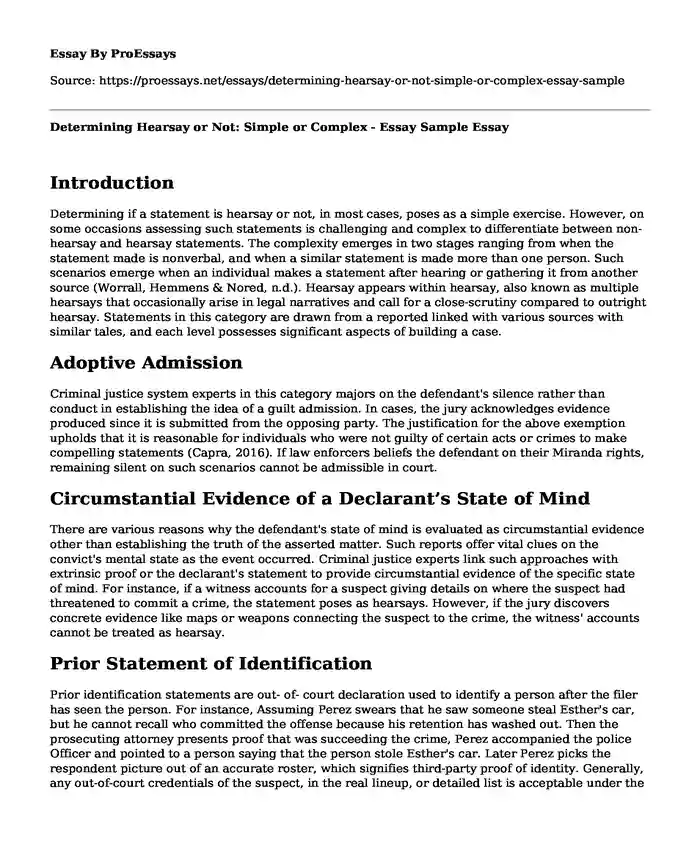Introduction
Determining if a statement is hearsay or not, in most cases, poses as a simple exercise. However, on some occasions assessing such statements is challenging and complex to differentiate between non-hearsay and hearsay statements. The complexity emerges in two stages ranging from when the statement made is nonverbal, and when a similar statement is made more than one person. Such scenarios emerge when an individual makes a statement after hearing or gathering it from another source (Worrall, Hemmens & Nored, n.d.). Hearsay appears within hearsay, also known as multiple hearsays that occasionally arise in legal narratives and call for a close-scrutiny compared to outright hearsay. Statements in this category are drawn from a reported linked with various sources with similar tales, and each level possesses significant aspects of building a case.
Adoptive Admission
Criminal justice system experts in this category majors on the defendant's silence rather than conduct in establishing the idea of a guilt admission. In cases, the jury acknowledges evidence produced since it is submitted from the opposing party. The justification for the above exemption upholds that it is reasonable for individuals who were not guilty of certain acts or crimes to make compelling statements (Capra, 2016). If law enforcers beliefs the defendant on their Miranda rights, remaining silent on such scenarios cannot be admissible in court.
Circumstantial Evidence of a Declarant’s State of Mind
There are various reasons why the defendant's state of mind is evaluated as circumstantial evidence other than establishing the truth of the asserted matter. Such reports offer vital clues on the convict's mental state as the event occurred. Criminal justice experts link such approaches with extrinsic proof or the declarant's statement to provide circumstantial evidence of the specific state of mind. For instance, if a witness accounts for a suspect giving details on where the suspect had threatened to commit a crime, the statement poses as hearsays. However, if the jury discovers concrete evidence like maps or weapons connecting the suspect to the crime, the witness' accounts cannot be treated as hearsay.
Prior Statement of Identification
Prior identification statements are out- of- court declaration used to identify a person after the filer has seen the person. For instance, Assuming Perez swears that he saw someone steal Esther's car, but he cannot recall who committed the offense because his retention has washed out. Then the prosecuting attorney presents proof that was succeeding the crime, Perez accompanied the police Officer and pointed to a person saying that the person stole Esther's car. Later Perez picks the respondent picture out of an accurate roster, which signifies third-party proof of identity. Generally, any out-of-court credentials of the suspect, in the real lineup, or detailed list is acceptable under the hearsay exemption.
Admission by Conduct
Admission revolves around direct links such as verbal statements or written documents about specific theories and truths or can be portrayed by individual conducts. In cases where people fail to deny allegations that if were not true, reasonable individuals would deny, ignites perceptions of a guilty mind. This category is as well exempted in the narratives of the hearsay rule. For instance, defendants resisting arrests or unsupportive responses to ongoing investigations, in most cases, equates to guilt admission. Supplementary categories of admission by conduct have less considerable significance due to policy regulations. For instance, if the offender offers to cater to expenses incurred like medical bills, it is less critical if it were to appear in court as an implied admission of guilt (McLain, 2016). Under hearsay exemptions, such evidence is not admissible since it portrays a strong policy standpoint desirables, unlike the idea of guilty parties taking responsibilities for their deeds.
Prior Statements
When a witness is testifying, there are prior statements that cannot be considered hearsay. Initially, if a witness makes a statement out of court that contradicts his or her testimony in court, that statement is not considered hearsay. For instance, before trial, when a witness tells the officer the suspect committed the crime and later in court, the witness attests that suspect did not commit the crime. Probably the out- of- court testimonial can be presented as evidence (Siegel, & Worrall, 2018). However, the Federal Rules of Evidence state that the previous affidavit can be considered exempt from Hearsay rule if the statement was exposed to the forfeit of perjury or it was made under pledge. Moreover, such declarations are only acceptable to contradict a motive or control of fabrication.
Conclusion
In general, statements that are accredited to illicit defendants or the party called in civil proceedings are known as Admission by party opponents. These statements are not well-thought-out as hearsay since the out-of-court spectator does not make them. Such admissions include: statement by party’s servant, employee or agent, party’s owner statement. However, admissions can either be spoken, written, or in nonverbal assertion form.
References
Capra, D. J. (2016). Expanding (or Just Fixing) the Residual Exception to the Hearsay Rule. Fordham L. Rev., 85, 1577. https://scholar.google.com/scholar?hl=en&as_sdt=0,5&qsp=4&q=hearsay+rule+prior+statements&qst=br
McLain, L. (2016). Hearsay and the Confrontation Clause. University of Baltimore School of Law Legal Studies Research Paper, (2017-04).
https://papers.ssrn.com/sol3/papers.cfm?abstract_id=2852522
Siegel, L. J., & Worrall, J. L. (2018). Essentials of criminal justice. Cengage Learning.
https://books.google.co.ke/books?hl=en&lr=&id=Ka9EDwAAQBAJ&oi=fnd&pg=PP1&dq=Criminal+Evidence+John+L.+Worrall&ots=BcnLwWHMES&sig=DkmhARbLEEmrZ6eoh9GGEoJBMeg&redir_esc=y#v=onepage&q=Criminal%20Evidence%20John%20L.%20Worrall&f=false
Worrall, J., Hemmens, C. and Nored, L., n.d. Criminal Evidence. oxford. https://bookshelf.vitalsource.com/#/books/9780190639334/cfi/0!/4/[email protected]:23.2
Cite this page
Determining Hearsay or Not: Simple or Complex - Essay Sample. (2023, Oct 15). Retrieved from https://proessays.net/essays/determining-hearsay-or-not-simple-or-complex-essay-sample
If you are the original author of this essay and no longer wish to have it published on the ProEssays website, please click below to request its removal:
- Distributive Justice
- Coalition for Human Immigration Rights of Los Angeles Paper Example
- Can Anyone Be Above the Law? Essay Example
- Essay Example on Capital Punishment: Historical Practice & Present Controversy
- Determining Hearsay or Not: Simple or Complex - Essay Sample
- Examination of Mental Health Reforms from Criminal Justice Perspective - Paper Example
- Supreme Court Justices - Free Essay Sample







